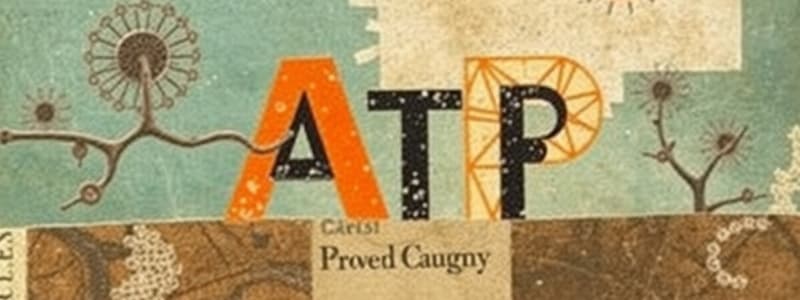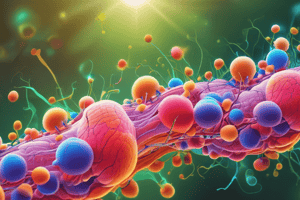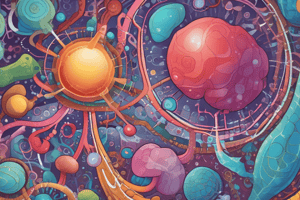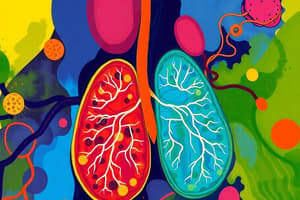Podcast
Questions and Answers
Which of the following best describes the primary role of ATP in cells?
Which of the following best describes the primary role of ATP in cells?
- To catalyze metabolic reactions by lowering the activation energy.
- To store genetic information for cell division.
- To act as the primary structural component of cell membranes.
- To serve as the main source of stored energy that can be readily used for various cellular activities. (correct)
During hydrolysis in the context of ATP, what molecule plays a crucial role in breaking down ATP into ADP?
During hydrolysis in the context of ATP, what molecule plays a crucial role in breaking down ATP into ADP?
- Carbon dioxide
- Water (correct)
- Glucose
- Oxygen
Which statement accurately describes the relationship between glucose, cellular respiration, and ATP?
Which statement accurately describes the relationship between glucose, cellular respiration, and ATP?
- ATP is broken down into glucose during cellular respiration to release energy.
- Cellular respiration breaks down glucose in the presence of oxygen to produce ATP, carbon dioxide, and water. (correct)
- Cellular respiration uses ATP to convert glucose into oxygen and water.
- Glucose is synthesized from ATP, carbon dioxide, and water during cellular respiration.
What are the three main stages of cellular respiration in the correct order?
What are the three main stages of cellular respiration in the correct order?
Why does ATP contain three phosphate groups?
Why does ATP contain three phosphate groups?
What is the net product from glycolysis alone of a single six-carbon glucose molecule?
What is the net product from glycolysis alone of a single six-carbon glucose molecule?
What is the chemical formula for glucose?
What is the chemical formula for glucose?
If a cell has plenty of glucose and oxygen available, but is unable to produce a normal amount of ATP due to a mitochondrial dysfunction, which stage of cellular respiration is most likely affected?
If a cell has plenty of glucose and oxygen available, but is unable to produce a normal amount of ATP due to a mitochondrial dysfunction, which stage of cellular respiration is most likely affected?
What is the net gain of ATP molecules resulting from glycolysis?
What is the net gain of ATP molecules resulting from glycolysis?
Under what conditions does fermentation occur, and what is its primary purpose?
Under what conditions does fermentation occur, and what is its primary purpose?
Where does the Krebs cycle take place within the cell?
Where does the Krebs cycle take place within the cell?
What happens to pyruvate before it enters the Krebs cycle?
What happens to pyruvate before it enters the Krebs cycle?
What is the role of NAD+ and FAD in the Krebs cycle?
What is the role of NAD+ and FAD in the Krebs cycle?
How many NADH and FADH2 molecules are produced per glucose molecule during the Krebs cycle?
How many NADH and FADH2 molecules are produced per glucose molecule during the Krebs cycle?
What is the primary function of the electron transport chain?
What is the primary function of the electron transport chain?
How does ATP synthase contribute to ATP production in the electron transport chain?
How does ATP synthase contribute to ATP production in the electron transport chain?
Approximately how many ATP molecules can be produced from each NADH molecule in the electron transport chain?
Approximately how many ATP molecules can be produced from each NADH molecule in the electron transport chain?
What is the total number of ATP molecules produced from a single glucose molecule through glycolysis, the Krebs cycle, and the electron transport chain?
What is the total number of ATP molecules produced from a single glucose molecule through glycolysis, the Krebs cycle, and the electron transport chain?
Flashcards
Cellular Respiration
Cellular Respiration
The process cells use to extract energy from food, especially glucose.
Glucose
Glucose
A simple sugar with the chemical formula C6H12O6; a primary source of energy for cells.
ATP (Adenosine Triphosphate)
ATP (Adenosine Triphosphate)
The molecule that serves as the main energy currency of the cell; powers cellular activities.
ATP Structure
ATP Structure
Signup and view all the flashcards
ATP Hydrolysis
ATP Hydrolysis
Signup and view all the flashcards
ADP (Adenosine Diphosphate)
ADP (Adenosine Diphosphate)
Signup and view all the flashcards
Glycolysis
Glycolysis
Signup and view all the flashcards
Pyruvic Acid (Pyruvate)
Pyruvic Acid (Pyruvate)
Signup and view all the flashcards
Fermentation
Fermentation
Signup and view all the flashcards
Lactic Acid Fermentation
Lactic Acid Fermentation
Signup and view all the flashcards
Aerobic Processes
Aerobic Processes
Signup and view all the flashcards
Acetyl Coenzyme A (Acetyl CoA)
Acetyl Coenzyme A (Acetyl CoA)
Signup and view all the flashcards
Citric Acid Cycle (Krebs Cycle)
Citric Acid Cycle (Krebs Cycle)
Signup and view all the flashcards
NAD+ and FAD
NAD+ and FAD
Signup and view all the flashcards
Main Goal of Krebs Cycle
Main Goal of Krebs Cycle
Signup and view all the flashcards
Electron Transport Chain
Electron Transport Chain
Signup and view all the flashcards
ATP Synthase
ATP Synthase
Signup and view all the flashcards
Study Notes
Cellular Respiration and ATP
- Cellular respiration is a complex process that scientists are still trying to fully understand, and it begins with the molecule ATP.
- This process produces energy within cells, especially animal cells.
- When working out at the gym, energy production and consumption are like participating in sports, and different exercises are similar.
- Energy production can be challenging but rewarding.
The Role of ATP
- Cellular respiration extracts energy from food, particularly glucose (C6H12O6).
- Glucose requires oxygen (6 oxygen molecules) to be converted into energy.
- Through cellular respiration, glucose and oxygen are converted into six molecules of carbon dioxide, six molecules of water, and energy.
- The body converts the initial energy into ATP (adenosine triphosphate).
- ATP serves as the "currency" of biological energy.
- Cells need ATP for growth, movement, sending electrical impulses (nerves and brains), and transporting materials in and out of membranes.
How ATP Works
- ATP consists of a nitrogenous base (adenine), a sugar (ribose), and three phosphate groups.
- The three phosphate groups of ATP repel each other.
- ATP releases energy by expelling a phosphate group, which then becomes ADP (adenosine diphosphate).
- Energy is released when a third phosphate is expelled, and a hydroxide ion (OH) from water replaces the phosphate group.
- Hydrolysis is the process of breaking down a compound using water (hydro = water, lysis = separating).
Cellular Respiration Stages
- Cellular respiration begins with oxygen and glucose.
- Ideally, cellular respiration transforms a single glucose molecule into heat and 38 ATP molecules.
- Typically, ~29-30 ATP molecules are produced per glucose molecule.
- Cellular respiration occurs in three stages: glycolysis, Krebs cycle, and electron transport chain.
- These stages occur simultaneously in the cell.
Glycolysis
- Glycolysis, the breakdown of sugar, converts a six-carbon glucose molecule into two three-carbon molecules (pyruvic acid or pyruvate).
- An investment of two ATP molecules yields four ATP molecules, for a net gain of two ATP molecules.
- Glycolysis also produces two pyruvate molecules and two high-energy NADH molecules.
- NADH comprises vitamin B (NAD+) combined with excited electrons and a hydrogen atom.
- Overall, glycolysis produces two ATP molecules and two NADH molecules.
Anaerobic Processes
- Glycolysis is anaerobic, meaning it can occur without oxygen, which is otherwise essential for cellular respiration.
- Without oxygen, pyruvate is processed through fermentation.
- Fermentation frees up NAD+ molecules, enabling glycolysis to continue when a cell lacks oxygen.
- In organisms such as yeast, fermentation yields ethyl alcohol.
- Human muscles produce lactic acid instead of Ethyl-Alcohol when lacking oxygen, causing muscle soreness.
- When oxygen is depleted, muscle cells use anaerobic cellular respiration, leading to lactic acid accumulation.
Krebs Cycle
- Glycolysis produces two ATP molecules.
- Cells require oxygen to produce the other ~30 energy molecules for cellular activities.
- The Krebs cycle and the electron transport chain are aerobic processes (require oxygen).
- Glycolysis takes place in the cytoplasm, while the Krebs cycle occurs in the inner membrane of the mitochondria.
- Pyruvate from glycolysis enters the Krebs cycle, yielding two more ATP molecules and other forms of energy.
- The first step is the oxidation of one of the pyruvates through combination with oxygen.
Acetyl Coenzyme A
- Carbon from the three-carbon chain binds with oxygen, leaving the cell as carbon dioxide.
- The remaining two-carbon compound becomes acetyl coenzyme A (acetyl CoA).
- Another NAD+ molecule binds to a hydrogen atom to become NADH.
- Two pyruvate molecules yield two NADH molecules for later use.
- Enzymes facilitate reactions, such as combining phosphate with ADP to create ATP.
- Enzymes combine acetyl coenzyme A with a four-carbon molecule (oxaloacetic acid) to form a six-carbon molecule (citric acid).
Citric Acid Cycle
- The Krebs cycle is also known as the citric acid cycle because of citric acid.
- The Krebs cycle derives its name from its discoverer, Hans Krebs.
- Hans Krebs, a surgeon who fled Nazi Germany, discovered the Krebs Cycle in 1937 and won the Nobel Prize in 1953.
- Citric acid is oxidized in a series of steps, releasing carbon atoms and eventually returning to oxaloacetic acid, thus completing the cycle.
- Carbon atoms removed from citric acid are released as carbon dioxide, which is exhaled.
Energy Storage
- Each removal of a carbon atom from citric acid produces energy stored in molecules other than ATP.
- NAD+ and its partner FAD, enzymes derived from vitamin B (niacin and riboflavin), capture and store high-energy electrons.
- NAD+s and FADs act as large batteries, capturing hydrogen and excited electrons from pyruvate to increase their energy.
- The addition of hydrogen converts them into NADH and FADH2, respectively.
- Each pyruvate molecule produces three NADH molecules and one FADH2 molecule per cycle.
- Because one glucose molecule breaks down into two pyruvate molecules, each glucose molecule generates six NADH molecules and two FADH2 molecules.
- The primary goal of the Krebs cycle is to produce these energy-rich molecules for the electron transport chain stage.
Electron Transport Chain
- ATP is produced in the electron transport chain.
- A highly efficient cell can produce 34 ATP molecules through the Electron Transport Chain
- Electrons from NADHs and FADH2 provide the energy to power transport proteins on the inner mitochondrial membrane.
- The mitochondrial membrane is where the Krebs cycle occurs.
- These transport proteins exchange electrons to send hydrogen protons from the mitochondrial matrix across the inner membrane.
- The protons then return due to the high concentration, seeking balance across the membrane.
- Protons return inside through ATP synthase.
- The energy creates a mechanism that combines ADP with phosphate to create ATP.
- Electrons from the ten NADH molecules produced during the Krebs cycle have enough energy to produce approximately 4 ATP molecules each, while each of the two FADH2 molecules produces 2 ATP molecules.
- Animal cells produce ATP in the electron transport chain through cellular respiration.
ATP Production Totals
- Two ATP molecules are produced from each pyruvate molecule through glycolysis and two in the Krebs cycle, adding up to 34 ATP molecules in the electron transport chain, all from a single glucose molecule.
Studying That Suits You
Use AI to generate personalized quizzes and flashcards to suit your learning preferences.




